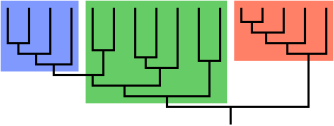Evolutionary grade

A grade is a taxon united by a level of
Phylogenetics
In order to fully understand evolutionary grades, one must first get a better understanding of
Definition of an evolutionary grade
An evolutionary grade is a group of species united by morphological or physiological traits, that has given rise to another group that has major differences from the ancestral group's condition, and is thus not considered part of the ancestral group, while still having enough similarities that we can group them under the same clade.[clarification needed] The ancestral group will not be phylogenetically complete (i.e. is not a clade), and so will represent a paraphyletic taxon.[citation needed]
The most commonly cited example is that of
Paraphyletic taxa will often, but not always, represent evolutionary grades. In some cases paraphyletic taxa are united simply by not being part of any other groups, and give rise to so-called wastebasket taxa which may even be polyphyletic.
Grades in systematics
The traditional Linnaean way of defining taxa is through the use of anatomical traits. When the actual phylogenetic relationship is unknown, well defined groups sometimes turn out to be defined by traits that are primitive rather than derived. In Linnaean systematics, evolutionary grades are accepted in higher taxonomic ranks, though generally avoided at family level and below. In phylogenetic nomenclature evolutionary grades (or any other form of paraphyly) are not accepted.[6]
Where information about phylogenetic relationships is available, organisms are preferentially grouped into
Evolutionary grades, being united by gross morphological traits, are often eminently recognizable in the field. While taxonomy seeks to eliminate paraphyletic taxa, such grades are sometimes kept as formal or informal groups on the basis of their usefulness for laymen and field researchers.[6] In bacteriology, the renaming of species or groups that turn out to be evolutionary grades is kept to a minimum to avoid misunderstanding, which in the case of pathogens could have fatal consequences. When referring to a group of organisms, the term "grade" is usually enclosed in quotation marks to denote its status as a paraphyletic term.
Grades and phylogenetic nomenclature
With the rise of
Examples
- Fish represent a grade, in as much as they have given rise to the land vertebrates. In turn, the three traditional classes of fish (Agnatha, Chondrichthyes and Osteichthyes) all represent evolutionary grades.[12]
- Amphibians in the biological sense (including the extinct Labyrinthodonts) represent a grade, since they are also the ancestors of the amniotes.[12]
- mammals.[4]
- Dinosaurs were proposed to be the ancestors of birds as early as the 1860s.[13] Yet the term sees popular use as an evolutionary grade excluding birds, though most scientists use a monophyletic Dinosauria.
- legless lizards, which are considered true lizards.
- land plants.
- fungi, and protists; and the last of these four groups also represents a grade, since it excludes the previous three groups.
- Crustaceans represent a grade, since they are the ancestors of hexapods, which includes insects and related taxa.
- Monkeys represent a grade, since they include the ancestors of apes (including humans).
- Likewise, apes represent a grade in common usage, but are a clade if humans are included.
References
- ^ Huxley J. 1959. Clades and grades. In Cain A.J. (ed) Function and taxonomic importance. Systematics Association, London.
- ^ "phylogeny". Biology online. Retrieved 15 February 2013.
- ^ Latreille, P.A. (1804). Nouveau Dictionnaire à Histoire Naturelle, xxiv; cited in Latreille, P.A. (1825).Familles naturelles du règne animal, exposés succinctement et dans un ordre analytique.
- ^ ISBN 0-19-860426-2.
- PMID 12361912.
- ^ PMID 21684957.
- S2CID 34175521. Archived from the original(PDF) on 9 May 2009. Retrieved 22 August 2012.
- S2CID 36988476.
- JSTOR 2992353.
- .
- S2CID 17851383. Archived from the originalon 5 June 2011.
- ^ a b Romer, A.S. & T.S. Parsons. 1977. The Vertebrate Body. 5th ed. Saunders, Philadelphia. (6th ed. 1985)
- doi:10.1144/GSL.JGS.1870.026.01-02.08 – via Wikisource.
- ISBN 978-0-8173-0135-4.
